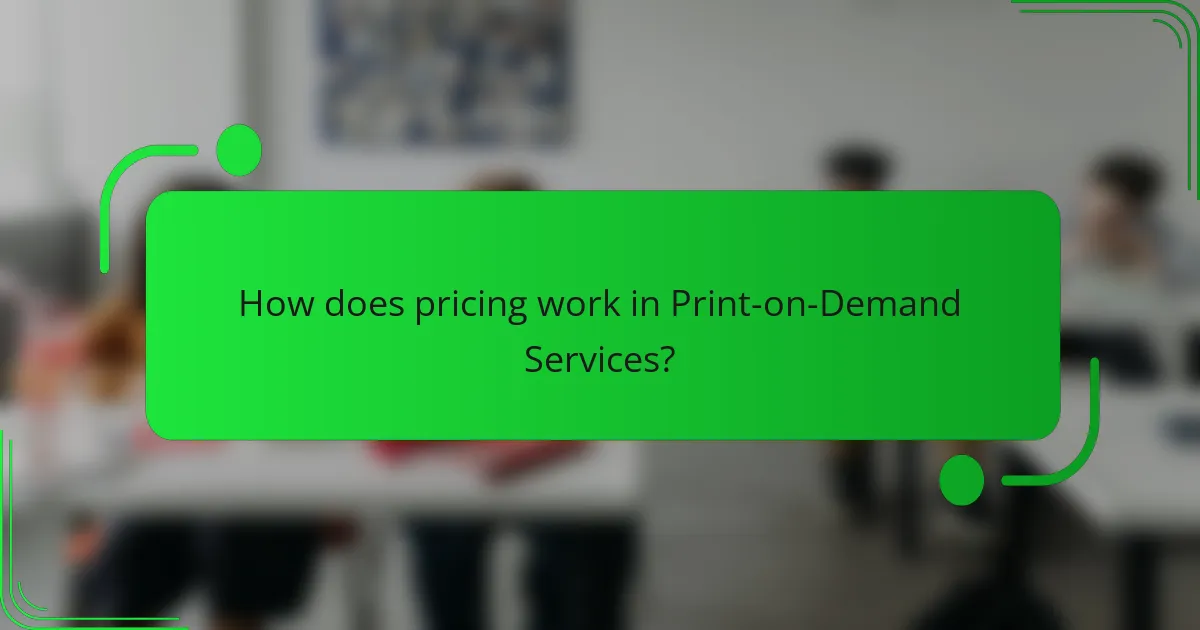Print-on-demand services offer a cost-effective solution for businesses looking to create custom products without the burden of inventory. This article explores the benefits of low startup costs, the pricing structure based on product type and specifications, and the challenges of quality control and supplier reliance. Additionally, we will examine key features of popular platforms and strategies for optimizing operations in this growing market.

What are Print-on-Demand Services?
Print-on-demand services allow individuals and businesses to create custom products without holding inventory. These services offer benefits like low startup costs, no inventory risk, and a wide range of customizable products. Pricing varies based on product type, printing method, and supplier, typically involving a base cost plus a markup for profit.
How do Print-on-Demand Services work?
Print-on-demand services allow individuals and businesses to create custom products without holding inventory. Users upload designs, and the service prints and ships items as orders come in. This model minimizes upfront costs and reduces waste.
Key benefits include low financial risk, diverse product offerings, and the ability to test market demand. Pricing varies based on product type, print quality, and order volume. For example, a custom t-shirt might cost between $10 to $30, depending on these factors.
What types of products can be created with Print-on-Demand?
Print-on-Demand services can create a wide variety of products. Common items include custom apparel, home decor, accessories, and stationery.
| Product Type | Description |
|———————|————————————–|
| Custom Apparel | T-shirts, hoodies, and leggings |
| Home Decor | Wall art, pillows, and blankets |
| Accessories | Tote bags, hats, and phone cases |
| Stationery | Notebooks, planners, and greeting cards |
| Mugs | Personalized drinkware |
| Stickers | Custom designs for various uses |

What are the advantages of using Print-on-Demand Services?
Print-on-Demand services offer several advantages that streamline the printing and distribution process. They eliminate the need for large upfront inventory costs, allowing creators to print items as orders come in. This model reduces waste by producing only what is sold. Additionally, Print-on-Demand services enable quick turnaround times, facilitating faster delivery to customers. They also provide a wide range of customizable products, enhancing brand visibility. Overall, these services empower businesses to operate efficiently and adapt to market demands.
How does Print-on-Demand reduce upfront costs?
Print-on-Demand significantly reduces upfront costs by eliminating the need for inventory and large print runs. This model allows businesses to print items only as orders are received, minimizing financial risk. Additionally, it lowers storage costs since products do not need to be stored in bulk. As a result, entrepreneurs can invest more in marketing and design rather than production.
Why is customization important in Print-on-Demand?
Customization is crucial in Print-on-Demand because it allows businesses to offer unique products tailored to customer preferences. This personalization enhances customer satisfaction and loyalty, driving sales. Furthermore, customization helps brands differentiate themselves in a competitive market. It enables the creation of niche products that cater to specific demographics, increasing engagement and repeat purchases. Ultimately, the ability to customize fosters innovation and creativity, providing a significant advantage in the Print-on-Demand industry.
What role does inventory management play in Print-on-Demand?
Inventory management is crucial in print-on-demand as it ensures efficient order fulfillment and minimizes costs. Proper inventory oversight prevents stockouts and overstock situations, enhancing customer satisfaction. Additionally, it allows for real-time tracking of print materials, which can lead to better resource allocation and waste reduction. Effective inventory management directly impacts profitability by optimizing the supply chain and reducing lead times.

How does pricing work in Print-on-Demand Services?
Pricing in Print-on-Demand services typically involves base costs for production, shipping fees, and a markup for profit. The base cost varies based on product type, material, and print specifications. For example, a custom t-shirt may have a base cost of $10, while a mug could start at $8. Shipping adds to the total, often depending on destination and delivery speed. Markup percentages usually range from 20% to 50%, allowing sellers to set their retail prices. Understanding these components helps sellers price their products competitively while ensuring profitability.
What factors influence the pricing of Print-on-Demand products?
Several factors influence the pricing of Print-on-Demand products, including production costs, shipping fees, and platform fees. Quality of materials and customization options also play a significant role in determining final prices. Additionally, market demand and competition impact pricing strategies. Understanding these elements helps businesses set competitive prices while maintaining profitability.
How do different platforms compare in terms of pricing?
Print-on-demand services vary significantly in pricing based on factors like product type, base costs, and shipping fees. Below is a comparison of six popular platforms.
Platform | Base Cost | Shipping Fee | Additional Fees | Volume Discounts | Customization Options
Printful | $12.00 | $5.00 | None | Yes | Yes
Teespring | $10.00 | $4.00 | None | Yes | Yes
Redbubble | $15.00 | $3.50 | None | No | Yes
Zazzle | $8.00 | $6.00 | None | Yes | Yes
TeeChip | $9.00 | $5.00 | None | Yes | Limited
Society6 | $14.00 | $4.50 | None | No | Yes
Each platform offers unique pricing structures, impacting overall profitability for sellers.

What are the unique features of popular Print-on-Demand platforms?
Popular Print-on-Demand platforms offer unique features that enhance user experience and product customization. Key features include integration with e-commerce platforms, extensive product variety, and customizable design tools.
| Feature | Description |
|——————————|—————————————————–|
| E-commerce Integration | Seamless connection with platforms like Shopify |
| Product Variety | Wide range of items including apparel and home goods|
| Custom Design Tools | User-friendly interfaces for personalized designs |
| Global Shipping Options | Delivery to multiple countries worldwide |
| No Inventory Management | Print items on demand, reducing upfront costs |
| Scalability | Ability to handle varying order volumes |
Which platforms offer the best integration with e-commerce sites?
Shopify, WooCommerce, and BigCommerce provide the best integration with print-on-demand services. These platforms streamline order processing, inventory management, and customer experience. Shopify offers a wide range of apps, including Printful and Printify, enhancing customization. WooCommerce integrates seamlessly with various POD plugins, allowing flexibility. BigCommerce supports multiple POD providers, ensuring scalability for businesses.
What are the shipping options available with various Print-on-Demand services?
Print-on-Demand services typically offer several shipping options, including standard, expedited, and international shipping. Standard shipping is the most economical but takes longer, while expedited shipping ensures faster delivery. International shipping varies by provider and may include additional customs fees. Some services provide tracking options for all shipping methods, enhancing customer experience.

What challenges do businesses face when using Print-on-Demand Services?
Businesses face several challenges when using Print-on-Demand services. Key issues include quality control, reliance on third-party suppliers, and inventory management complexities.
Quality can vary significantly between providers, impacting customer satisfaction. Additionally, businesses often depend on these suppliers for timely fulfillment, which can lead to delays and inconsistent service. Inventory management becomes complicated since businesses must track orders without holding physical stock, making demand forecasting crucial.
Understanding these challenges is essential for businesses to optimize their use of Print-on-Demand services and enhance operational efficiency.
How can quality control issues be managed in Print-on-Demand?
Quality control issues in Print-on-Demand can be managed through systematic processes. Implement quality checks at each production stage, from design to final product. Use reliable suppliers to ensure material consistency. Regularly review customer feedback to identify recurring problems. Train staff on quality standards to maintain production integrity. Utilize technology for automated quality assessments, reducing human error.
What are common fulfillment delays associated with Print-on-Demand?
Common fulfillment delays in Print-on-Demand include production time, shipping issues, and inventory shortages. Production delays often arise from high demand or equipment malfunctions. Shipping delays can occur due to carrier disruptions or customs processing. Inventory shortages may happen if suppliers cannot meet demand for specific materials. Understanding these factors helps manage customer expectations effectively.

What are the trends shaping the future of Print-on-Demand Services?
Print-on-Demand services are increasingly shaped by technology, sustainability, and personalization. Advancements in printing technology enhance quality and speed, while eco-friendly materials attract environmentally conscious consumers. Additionally, customization options allow businesses to offer unique products, catering to individual preferences. These trends drive growth and adaptability in the Print-on-Demand market.
How is technology influencing Print-on-Demand innovation?
Technology significantly enhances Print-on-Demand innovation by streamlining production and improving customization. Advanced printing techniques enable higher quality outputs, while data analytics optimize inventory management. Automation reduces turnaround times, allowing faster fulfillment. Moreover, integration with e-commerce platforms facilitates seamless order processing, expanding market reach. These advancements collectively enhance user experience and operational efficiency in the Print-on-Demand sector.
What emerging markets are adopting Print-on-Demand Services?
Emerging markets adopting Print-on-Demand services include Brazil, India, Mexico, and South Africa. These regions are experiencing growth due to increased internet access and a rise in e-commerce. Print-on-Demand allows local entrepreneurs to offer customized products without significant upfront costs. As a result, these markets are benefiting from lower inventory risks and the ability to cater to niche audiences.

How can businesses optimize their use of Print-on-Demand Services?
Businesses can optimize their use of Print-on-Demand services by implementing strategic practices. First, they should select a niche market to target specific customer needs. This helps in creating tailored designs that resonate with the audience. Second, leveraging high-quality product images and descriptions enhances the perceived value, driving conversions. Third, utilizing data analytics to track sales trends and customer preferences enables informed decision-making for inventory and design adjustments. Finally, establishing strong partnerships with reliable Print-on-Demand providers ensures timely fulfillment and quality control, impacting customer satisfaction positively.
What best practices should be followed for successful Print-on-Demand campaigns?
Successful Print-on-Demand campaigns require strategic planning and execution. Focus on high-quality designs, target audience research, and effective marketing strategies.
1. Choose a niche that resonates with your audience.
2. Create compelling designs that stand out.
3. Optimize product descriptions for search engines.
4. Utilize social media and influencer partnerships for promotion.
5. Monitor performance metrics and adjust strategies accordingly.
What common mistakes should be avoided when starting with Print-on-Demand?
To succeed in Print-on-Demand, avoid common pitfalls such as neglecting market research, underestimating production costs, and failing to optimize product listings.
1. Skipping market research leads to uninformed product choices, risking low sales.
2. Underestimating production costs can erode profit margins, making pricing uncompetitive.
3. Ignoring SEO for product listings results in poor visibility, limiting customer reach.
4. Overlooking quality control can damage brand reputation, leading to negative reviews.
5. Failing to test products before launch may result in unsatisfactory customer experiences.
6. Not diversifying product offerings can restrict potential sales channels.



